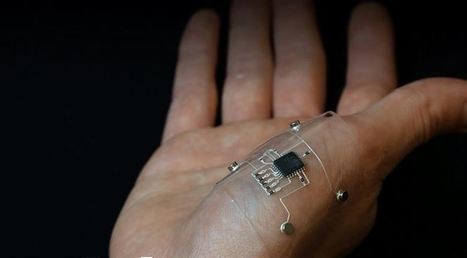Force, leveraging the expertise and insights of academia has led to advances in materials development and processing destined to be a game changer for the future fight.
A collaboration between scientists at the Air Force Research Laboratory and Harvard University’s Wyss Institute for Biologically Inspired Engineering has resulted in a new method for digital design and printing of stretchable, flexible electronics. The process, called Hybrid 3-D printing, uses additive manufacturing to integrate soft, conductive inks with a material substrate to create stretchable, wearable electronic devices.
“This is the first time a 3-D printer has been shown, in a single process, to print stretchable sensors with integrated microelectronic components,” said Dr. Dan Berrigan, a research scientist at the AFRL Materials and Manufacturing Directorate. “Starting from nothing, the printer builds an entire stretchable circuit that blends the mechanical durability of printed components with the robust performance of off-the-shelf electronics.”
In this demonstration, a 3-D printer was used to print conductive traces of flexible, silver-infused thermoplastic polyurethane. A pick-and-place method was then used to set microcontroller chips and LED lights into the flexible substrate, augmented by an empty printer nozzle and vacuum system to create the hybrid system.
When tested, the additively manufactured, hybrid-electronic devices were able to maintain function even after being stretched by more than 30 percent from original size.
“This has a lot of potential for Air Force applications, particularly in the areas of rapid prototyping, wearable electronics, sensors and human performance monitoring,” said Berrigan. “Skin-worn electronics have the potential to provide feedback on movement, body temperature, fatigue, hydration and other metrics crucial to understanding Airmen performance. However, while skin is inherently soft and stretchable, electronics and sensors are not.”
Learn more / En savoir plus / Mehr erfahren:
https://www.scoop.it/t/21st-century-innovative-technologies-and-developments/?&tag=wearables
https://www.scoop.it/t/21st-century-innovative-technologies-and-developments/?&tag=Electronics



 Your new post is loading...
Your new post is loading...








Learn more / En savoir plus / Mehr erfahren:
https://www.scoop.it/t/21st-century-innovative-technologies-and-developments/?&tag=wearables
https://www.scoop.it/t/21st-century-innovative-technologies-and-developments/?&tag=Electronics